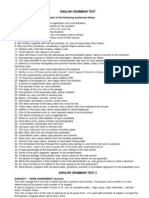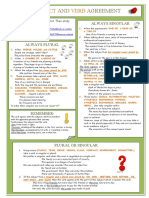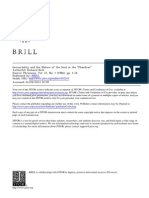Agreement of Subject and Verb
Agreement of Subject and Verb
Uploaded by
bernaflor pacantaraCopyright:
Available Formats
Agreement of Subject and Verb
Agreement of Subject and Verb
Uploaded by
bernaflor pacantaraCopyright
Available Formats
Share this document
Did you find this document useful?
Is this content inappropriate?
Copyright:
Available Formats
Agreement of Subject and Verb
Agreement of Subject and Verb
Uploaded by
bernaflor pacantaraCopyright:
Available Formats
Agreement of Subject and Verb
1. Indefinite pronouns as each, everyone, everybody, someone, no one, nobody, take a singular
verb.
Every shopper wants to get the most out of their peso.
Each of the winners in the contests receives a trophy.
Nobody was chosen to represent the school.
2. Use either singular or plural verb with any, such, or none depending upon their meaning in the
sentence.
None of the cake was eaten.
None of us are ready.
3. If the subject is all, more, most, part, or some and is followed by an “of phrase”, use a verb that
agrees with the subject of that “of phrase”.
All of that is mine. All of us are going.
Part of the ribbon has been cut. Part of the ribbons are frayed.
4. Collective nouns taken as a unit or as a whole takes singular verbs. When members of the
collective noun are thought of individually the noun takes a plural verb.
The class agrees on the date of its first reunion.
The class do not agrees on the project they have put up.
5. Compound subjects connected by “and” take a plural verb unless the subjects mean the same
person or thing or are closely associated in meaning. If different persons or items are meant,
plural verb is used.
Depression and pessimism are two states of mind that look alike.
My best friend and cousin is leaving for New York.
The president of the company and the general manager are here.
6. In compound subjects connected by either-or and neither-nor, the verb agrees with the nearest
subject.
Either you or I am not ready to solve the problem.
Either the boy scouts or their scout master is ready for the activity.
Either the student or his teachers are to blame.
7. The verb agrees with the subject not with the predicate word.
The main reason for his failure is his absences in the class.
My objection to illegal logging is the many dangers to be encountered like flash floods,
soil erosion etc.
8. The expression a number is plural; the expression the number is singular.
The number of childbirth is reduced to family planning and abortion.
A number of smuggled electronics were found in an old warehouse.
9. Words intervening between the subject and the verb do not affect the verb.
Gerry, with his friend is ready for the catering services.
Mr. Tan’s mansion including all the furnishing’s in it, was sold for 10 million pesos.
10. Nouns ending in s but singular in meaning take singular verbs.
Statistics is the subject that challenges Miriam most.
The news this morning is very alarming.
11. Use singular verbs with nouns that are always singular in form; use plural verbs with their
plural equivalents.
Bread, a slice/ a loaf loaves/ slices of bread
Furniture, a piece of pieces of furniture
Equipment pieces/ kinds of equipment
The furniture was bought from Laguna.
The pieces of furniture make the living room look cozy.
12. Use plural verbs with nouns generally used in the plural. Singular equivalents of some of these
nouns take singular verbs.
Scissors, trousers, pants, jeans, shorts, tongs, pliers
13. An amount of money, time, distance or a unit of measurement takes a singular verb.
With today’s expensive fare and food, five hundred pesos is not enough.
Three months vacation is what I need.
Six hundred tons is the capacity of the truck.
Ten meters is enough for the curtain.
14. Fractions are singular or plural depending upon the use of “of phrase”.
One third of the class was used as subject of this study.
One-fourth of the water melons are over ripe.
15. Words like some, a few, many take plural verb.
Many are called but few are chosen.
16. A verb that has a relative pronoun as its subject agrees with the antecedent of that pronoun.
Henry is one person who works hard.
Dina is one of the girls who usually arrive early.
17. The expression there is is followed by singular noun; the expression there are is followed by
plural.
There are many job opportunities in the U.S.
There is no electricity in the remote barrio.
18. When the subject is a title of a book, a clause, a quotation or a group of words expressing a
single idea, the verb is singular.
“Loneliness makes the loudest noise” is an ambiguous statement to some.
“Trees” is the title of the famous poem of Joyce Kilmer.
Women’s Journal is my favorite magazine.
19. It when used to introduce a sentence is followed by a singular verb whether the noun that
follows it is singular or plural.
It is the parents who should be responsible for their children.
20. In the use of arithmetical expressions, the following are accepted.
Ten plus ten is twenty.
One and one are two.
One-fourth of twelve is three.
Ten times ten is one hundred.
Twenty-five minus twelve is thirteen.
21. Adjectives used as nouns are considered plural.
The poor are blessed.
The blind, the deaf , and the mute need our government’s support.
First Quarterly Long Test in English 7
Name: ___________________________ Yr./Sec.: _______________
Date: _____________
I. Subject and Verb Agreement: Underline the correct form of the verb.
1. A great part of the tribes ( is, are ) Jews.
2. Ruben is just another of those teenagers who ( thinks, think ) much of themselves.
3. The best part of the book ( is, are ) the illustrations.
4. The whole series of police operations against drugs ( was, were) successful.
5. All possible means ( has, have) been adopted to ensure safety.
6. The committee who investigated the scam (was, were) men of unquestionable dignity.
7. The earth’s ( is, are) three-fourths water.
8. The rest of the members of the mountain climbers (was, were) lost.
9. The wages of sin ( is, are ) death.
10. Five thousand pesos (was, were) kept in the drawer.
11. Among the chief causes of students’ failure ( is, are) negligence and carelessness.
12. A tribe of Jews (forms, form) the dominant race of people in South of Israel.
13. The building together with all its equipment (was, were) razed by fire.
14. Politics in the Philippines ( is,, are) dirty.
15. The industrious (deserve, deserves) the award.
16. Neither the civilians nor the soldiers (was, were) badly hurt.
17. The graduating class (requests, request) the pleasure of your company.
18. A number of rebels (was, were) killed in the encounter in Mindanao.
19. There (is, are) many human rights violations during the martial law.
20. You, who (refuses, refuse) to testify is partly to be blamed.
II. Identification.
Identify what is asked. Choose your answer on the box below.
Setting characters plot exposition complication climax
Denoument point of view theme literature
_________________21. It is the time and location where the story takes.
_________________22. They are the make-believe persons who carry out the ation of the story.
_________________23. It lays out the main characters, their backgrounds, characteristics, interests, goals and
limitations.
_________________24. It is the onset of the major conflict in the plot.
_________________25. It is the story’s highest point which may take the shape of a decision, an action, an
affirmation, or a realization.
_________________26. It is the way the actions are arranged in the story.
_________________27. It determines who tells the story.
_________________28. It is the finishing of things right after the climax.
_________________29. It described as the significant truth about life and human nature.
_________________30. It is any body of written works that is considered to be an art form.
III. Answer briefly yet concisely.
A. Creation of the World
1. Who was Diwata?
2. What creation dis she make aside from the old man and old woman?
B. How the Earth was Created
1. How did Sualla create the first man and the first woman?
2. Why did Sinonggol turn the medicine into poison?
3. Tell how the earth was formed.
4. What is the origin of the following: rice, bananas, the wild pig, the rat? ( 4 pts. )
C. Why the Sky is High
1. Who were the two brothers?
2. According to the story, how did the moon and the stars originate?
3. Why did the woman tell the sky to rise higher?
IV. Spelling ( 1-18 )
I. Learning Objective
1. Use the parts/sections of a newspaper in locating desired information
II. Subject Matter
A. Topic; Using the parts/sections of the newspaper
B. References
C. Materials: clippings, newspapers, blank sheets of manila paper, pentel pens
III. Procedure
A. Preparatory Activities
Review
Invite the pupils to play the scrambled letters.
a. Group pupils into five’s.
b. Give each group an envelop containing sets of letters like D N X I L.
c. The leade of the class or the teacher reads the questions on the strips of paper
d. The group arranges the letters to form the correct word.
e. The group with the correct words formed is the winner. E.g. It contains a list of topics that are
arranged alphabetically with their pages.
Questions:
1. This page contains the contents of the book and pages.
2. It contains the right of the author to publish the book.
3. It contains the list of references used in the book.
4. It gives the purpose of the auhor in writing the book.
Motivation
1. Show samples of newspapers. Ask; have you seen these before? What do we call these? Are they important
to us?
2. Pose the question. What information do newspapers give us?
Dvelopmental Activities
Presentation
You might also like
- Eng1l - Unit 1Document61 pagesEng1l - Unit 1api-266151891100% (4)
- The ESL Miscellany: A Treasury of Cultural and Linguistic InformationFrom EverandThe ESL Miscellany: A Treasury of Cultural and Linguistic InformationNo ratings yet
- English Grammar ReviewerDocument20 pagesEnglish Grammar ReviewerMa'am Anj100% (2)
- M1 Language Systems GrammarDocument16 pagesM1 Language Systems GrammarMahgoub AlarabiNo ratings yet
- Morphological Analysis of IndonesianDocument12 pagesMorphological Analysis of IndonesianViciAlfananiNo ratings yet
- English 7 PPT UpdatedDocument47 pagesEnglish 7 PPT UpdatededylopezchangNo ratings yet
- English 6 Subject-Verb AgreementDocument26 pagesEnglish 6 Subject-Verb AgreementEstelita Alcantara Javier100% (1)
- Subject Verb ConcordDocument4 pagesSubject Verb ConcordWilliam MassimoNo ratings yet
- Subject Verb AgreementDocument26 pagesSubject Verb AgreementCatherine RenanteNo ratings yet
- Teologo English10 Q4WEEK6Document3 pagesTeologo English10 Q4WEEK6James Daniel L. Basco:No ratings yet
- Gen - Ed English Students' HandoutsDocument20 pagesGen - Ed English Students' HandoutsBabes GonzNo ratings yet
- Lesson Plan in Subject Verb AgreementDocument5 pagesLesson Plan in Subject Verb AgreementKATE CRUZ100% (3)
- Subject Verb Agreement q1w9Document39 pagesSubject Verb Agreement q1w9Dronio Arao L-sa100% (1)
- Module 2 English 30Document3 pagesModule 2 English 30collegeofeducation161No ratings yet
- Subject Verb Agreement q1w9Document39 pagesSubject Verb Agreement q1w9Myprimadona GanotisiNo ratings yet
- Subject and Verb AgreementDocument8 pagesSubject and Verb AgreementJana Alexa Del RosarioNo ratings yet
- Subject Verbagreement 120823085311 Phpapp02 2Document31 pagesSubject Verbagreement 120823085311 Phpapp02 2Jonathan Delos SantosNo ratings yet
- Subject-Verb Agreement - Lesson PlanDocument6 pagesSubject-Verb Agreement - Lesson PlanEzekiel D. Rodriguez92% (25)
- Subject-Verb AgreementDocument31 pagesSubject-Verb AgreementKerwin MallorcaNo ratings yet
- Subject Verb AgreementDocument29 pagesSubject Verb AgreementBanti DaphalNo ratings yet
- Module 1 - LESSON 3Document11 pagesModule 1 - LESSON 3Alfie LariosaNo ratings yet
- The Story of The Aged Mother G8 PRONOUNSDocument3 pagesThe Story of The Aged Mother G8 PRONOUNSSabella Zachary03No ratings yet
- Agreement of Subject and VerbDocument3 pagesAgreement of Subject and VerbErly Ambito LeosalaNo ratings yet
- Clase No. 5Document7 pagesClase No. 5den alNo ratings yet
- Subject Verb ConcordDocument8 pagesSubject Verb Concordallens6stdb2No ratings yet
- Subject Verb AgreementDocument5 pagesSubject Verb Agreementchristine manaloNo ratings yet
- Lesson Plan EnglishDocument4 pagesLesson Plan EnglishbansmangindalatNo ratings yet
- Subject-Verb Agreement PDFDocument5 pagesSubject-Verb Agreement PDFKatrina BulgarNo ratings yet
- Subject-Verb AgreementDocument5 pagesSubject-Verb AgreementLodee BasaliNo ratings yet
- English Let ReviewerDocument50 pagesEnglish Let ReviewerAirra MaeNo ratings yet
- John Paul L. Hablado: DiscussantDocument28 pagesJohn Paul L. Hablado: DiscussantJohn Paul HabladoNo ratings yet
- Basic Rules in Agreement & GrammarDocument9 pagesBasic Rules in Agreement & GrammarJeiril DivinoNo ratings yet
- Lecture 1 - NounDocument4 pagesLecture 1 - NounSumaira BilalNo ratings yet
- SPN1 Final ExamsDocument8 pagesSPN1 Final ExamsGabriel Mendoza JoleNo ratings yet
- Module 1Document15 pagesModule 1Monnay MousNo ratings yet
- Subject Verb AgreementDocument2 pagesSubject Verb Agreementjnstory.onlinesvcsNo ratings yet
- Subject Verb Concord: 1.numberDocument6 pagesSubject Verb Concord: 1.numberMalamma PittathaNo ratings yet
- M2 L1Document6 pagesM2 L1Philip Pippo BuonoNo ratings yet
- Rules in Subject-Verb AgreementDocument3 pagesRules in Subject-Verb AgreementhazeViiNo ratings yet
- John Paul L. Hablado: DiscussantDocument28 pagesJohn Paul L. Hablado: DiscussantJohn Paul HabladoNo ratings yet
- Subject-Verb AgreementDocument15 pagesSubject-Verb Agreementlalitha deviNo ratings yet
- Structure of English - Subject-Verb Agreement Saint Louis Review Center (SLRC) Let Reviewer For English Majors (Language)Document7 pagesStructure of English - Subject-Verb Agreement Saint Louis Review Center (SLRC) Let Reviewer For English Majors (Language)raffyNo ratings yet
- Subject Verb Agreement 1 and 2Document9 pagesSubject Verb Agreement 1 and 2afvrebeccaNo ratings yet
- 02 CC S-V Agreement PDFDocument12 pages02 CC S-V Agreement PDFBerna Calugtong de LeonNo ratings yet
- Planes Primaria 23-27 MayoDocument7 pagesPlanes Primaria 23-27 MayoaxetletniNo ratings yet
- Reviewer in English: Sample Test 1Document9 pagesReviewer in English: Sample Test 1Bill Jerson D. EvangelistaNo ratings yet
- LAS #1 - Subject-Verb Agreement and Correct UsageDocument4 pagesLAS #1 - Subject-Verb Agreement and Correct UsageEldei ArchwingNo ratings yet
- Eng3 Quarter1 Module 6 and 7 - V4Document14 pagesEng3 Quarter1 Module 6 and 7 - V4John Benedict CruzNo ratings yet
- 2nd Grading - LP English ViDocument84 pages2nd Grading - LP English ViEna Borlat0% (1)
- English Grammar Free NotesDocument555 pagesEnglish Grammar Free Notesguyo bazuNo ratings yet
- Musa LPDocument4 pagesMusa LPbansmangindalatNo ratings yet
- 308 Subject-Pred AgreementDocument9 pages308 Subject-Pred AgreementGabuu25No ratings yet
- The 20 Rules of Subject Verb AgreementDocument9 pagesThe 20 Rules of Subject Verb Agreementpancake_ilagan0780% (5)
- ConcordDocument40 pagesConcordMaricar Corina CanayaNo ratings yet
- Rules On Subject Verb AgreementDocument2 pagesRules On Subject Verb AgreementKRISTINE MAE GUERRANo ratings yet
- Jawaban S V AgreementDocument5 pagesJawaban S V AgreementAyunda RahmadiniNo ratings yet
- Sept. 14 DLPDocument4 pagesSept. 14 DLPMark Christian CabanillaNo ratings yet
- English Grammar Test 3Document7 pagesEnglish Grammar Test 3Norman SernaNo ratings yet
- Subject Verb: AND AgreementDocument3 pagesSubject Verb: AND AgreementViktoriia OstapenkoNo ratings yet
- 2.english Grammar Subject-Verb AgreementDocument26 pages2.english Grammar Subject-Verb Agreementankamgude100% (4)
- DLL - 1st - Quarter - wk2 - Grade8 September 4 8 2023 Mr. TrinidadDocument5 pagesDLL - 1st - Quarter - wk2 - Grade8 September 4 8 2023 Mr. Trinidadbernaflor pacantaraNo ratings yet
- LAC Session No. 5 06 02 2023Document2 pagesLAC Session No. 5 06 02 2023bernaflor pacantaraNo ratings yet
- DLL 1st Quarter wk5 G8 September-25-29Document6 pagesDLL 1st Quarter wk5 G8 September-25-29bernaflor pacantaraNo ratings yet
- English 8-Q1-TEST-SY2022-2023Document9 pagesEnglish 8-Q1-TEST-SY2022-2023bernaflor pacantaraNo ratings yet
- EN8 Diagnostic Test SY2023 2024Document8 pagesEN8 Diagnostic Test SY2023 2024bernaflor pacantara100% (1)
- DLL - 3rd - Quarter - wk4 - Grade8-March 6-10-2023Document7 pagesDLL - 3rd - Quarter - wk4 - Grade8-March 6-10-2023bernaflor pacantaraNo ratings yet
- DLL 1st Quarter wk4 Grade8-September-18-22-2023Document5 pagesDLL 1st Quarter wk4 Grade8-September-18-22-2023bernaflor pacantara100% (1)
- Final G8 Q2 Test Sy2022 2023Document7 pagesFinal G8 Q2 Test Sy2022 2023bernaflor pacantaraNo ratings yet
- Quarter 3 Worksheet 1Document4 pagesQuarter 3 Worksheet 1bernaflor pacantaraNo ratings yet
- W5 Types of ParagraphDocument18 pagesW5 Types of Paragraphbernaflor pacantaraNo ratings yet
- Week 2Document9 pagesWeek 2bernaflor pacantaraNo ratings yet
- DLL 3rd Quarter wk1 Grade8-February-13-17-2023Document6 pagesDLL 3rd Quarter wk1 Grade8-February-13-17-2023bernaflor pacantaraNo ratings yet
- Grade 8 Summative Test For Quarter 1 Module 1 - 2Document2 pagesGrade 8 Summative Test For Quarter 1 Module 1 - 2bernaflor pacantaraNo ratings yet
- Template Records Pre Assessment CALLERSDocument41 pagesTemplate Records Pre Assessment CALLERSbernaflor pacantaraNo ratings yet
- School Based Deworming ProgramDocument5 pagesSchool Based Deworming Programbernaflor pacantaraNo ratings yet
- Q3 WS1 Answer-KeyDocument3 pagesQ3 WS1 Answer-Keybernaflor pacantaraNo ratings yet
- DLL 3rd Quarter wk1 Grade8-February-20-24-2023Document9 pagesDLL 3rd Quarter wk1 Grade8-February-20-24-2023bernaflor pacantaraNo ratings yet
- 2nd Quarter Grade 8Document1 page2nd Quarter Grade 8bernaflor pacantara100% (1)
- English Month 2021Document13 pagesEnglish Month 2021bernaflor pacantaraNo ratings yet
- Narrative - Report - Balara High SchoolDocument4 pagesNarrative - Report - Balara High Schoolbernaflor pacantaraNo ratings yet
- DEPARTMENT LAC PLAN Template EnglishDocument4 pagesDEPARTMENT LAC PLAN Template Englishbernaflor pacantaraNo ratings yet
- First Quarterly Long Test in English 7Document1 pageFirst Quarterly Long Test in English 7bernaflor pacantaraNo ratings yet
- 1st GRADING CARD DISTRIBUTIONDocument2 pages1st GRADING CARD DISTRIBUTIONbernaflor pacantaraNo ratings yet
- Incoming GRADE 8 FORMAT Creation of Depedqc - PH Student AccountsDocument4 pagesIncoming GRADE 8 FORMAT Creation of Depedqc - PH Student Accountsbernaflor pacantaraNo ratings yet
- School Form 5 Report On Promotion and Learning Progress AchievementDocument4 pagesSchool Form 5 Report On Promotion and Learning Progress Achievementbernaflor pacantaraNo ratings yet
- Sf3 - 2022 - Grade 8 (Year II) - FalconDocument3 pagesSf3 - 2022 - Grade 8 (Year II) - Falconbernaflor pacantaraNo ratings yet
- Grammatical Errors in Students' Abstract TranslationDocument6 pagesGrammatical Errors in Students' Abstract TranslationPhương VũNo ratings yet
- What Is ConcordDocument6 pagesWhat Is ConcordAjisafe Jerry T-moneyNo ratings yet
- Semantics Chapter 2.1Document35 pagesSemantics Chapter 2.1Thị Bo The Chú ChóNo ratings yet
- English - Parts of SpeechDocument49 pagesEnglish - Parts of SpeechMuhammad IqbalNo ratings yet
- Libro de Primer Nivel Abril-Agosto 20Document150 pagesLibro de Primer Nivel Abril-Agosto 20maylingarses123No ratings yet
- EwqewqewqewqewqDocument2 pagesEwqewqewqewqewqdsadsadasdNo ratings yet
- Ielts General Training Volume 3 - Listening Practice Test 2 v9 2390Document36 pagesIelts General Training Volume 3 - Listening Practice Test 2 v9 2390Artur BochkivskiyNo ratings yet
- Clauses and SentencesDocument56 pagesClauses and Sentencesbbyk117100% (1)
- Subject Verb AgreementDocument24 pagesSubject Verb AgreementLakshya GandhiNo ratings yet
- Translation MethodDocument20 pagesTranslation Methodmuhardianto 2112No ratings yet
- 4 WeekDocument7 pages4 Weekhidalgonicole854No ratings yet
- Descriptive TextDocument27 pagesDescriptive TextJojoNo ratings yet
- Test Specification Table Primary SchoolDocument3 pagesTest Specification Table Primary SchoolPuteri AdlinaNo ratings yet
- Relative Pronouns - Definition, List & ExamplesDocument12 pagesRelative Pronouns - Definition, List & ExampleswagnergarrenNo ratings yet
- Japanese Sentence Connector Cheat SheetDocument4 pagesJapanese Sentence Connector Cheat SheetLimSiEianNo ratings yet
- NLP Practitioner Study Cards - Branded Reformatted 2019 24363Document34 pagesNLP Practitioner Study Cards - Branded Reformatted 2019 24363dee Phillips100% (3)
- Inglés - Presencial - Luis ArévaloDocument3 pagesInglés - Presencial - Luis ArévaloAriadna Vilca BallonNo ratings yet
- Italian Definite ArticlesDocument11 pagesItalian Definite ArticlesadrianrocchioNo ratings yet
- Adjectives - MergedDocument96 pagesAdjectives - Mergedstdy.material25No ratings yet
- Particle and PrepositionDocument8 pagesParticle and PrepositionYulinda EkaNo ratings yet
- Materi Toefl 22-23Document44 pagesMateri Toefl 22-23YopenmardiansyahNo ratings yet
- 04 Modul 2022 - 12 Ips - Bahasa InggrisDocument65 pages04 Modul 2022 - 12 Ips - Bahasa InggrisAsyer SimanjuntakNo ratings yet
- Bài Tập Năng Cao I Learn Smart World 7 (Cập Nhật) Unit 5 Bản HSDocument7 pagesBài Tập Năng Cao I Learn Smart World 7 (Cập Nhật) Unit 5 Bản HSKhanh VyNo ratings yet
- Phrase Structure Guidelines PDFDocument303 pagesPhrase Structure Guidelines PDFmghsolutionsNo ratings yet
- GothicDocument309 pagesGothicOmid DjalaliNo ratings yet
- Foley&HallDocument194 pagesFoley&HallAnna ZasadaNo ratings yet
- Immortality and The Nature of The Soul in The Phaedrus PDFDocument27 pagesImmortality and The Nature of The Soul in The Phaedrus PDFAlex Madis100% (1)



















































































































